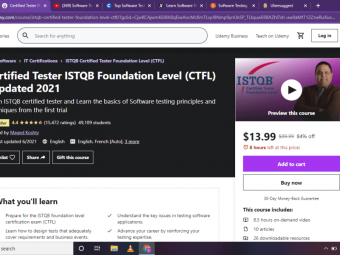Introduction To Oil And Gas Platform Design
Tags: Oil and Gas Industry
Comprehensive Course dedicated to the Overview of Oil and Gas Industry by Working on Specific Project
Last updated 2022-01-10 | 4.5
- The Fundamentals of Upstream Processes- Developing familiarity with common "oil field" terms and phrases.
- Defining the Reservoir Composition
What you'll learn
* Requirements
* There are no pre-requesites for this course. The fundamental and solid background will be delivered to the course takers.Description
Introduction to Oil and Gas Platform Design training course provided by Velocis Solutions aims to deliver the most fundamental and practical information about how oil and gas platforms work, what process engineers do in oil and gas platforms, types of equipment and their design. The course is a part of bundle including Separation in Oil and Gas Platforms and Liquid Hydraulics (Pump and Compressor Design). Besides the practical and comprehensive information, you will have a chance to get into depth by looking through the questions in lectures and assignments.
Let's have a glance at our content. The course starts with the objectives of the course so more or less you will have an idea of what to expect from this training. Then, introduction part is provided for Oil and Gas Platform Design. Turning to the main parts of the course, be informed that the course materials are delivered in three main parts including:
Composition - how composition data is established by analyzing the results from the laboratory together with working on fluids compositions comprising the following topics:
Mass/Mol fraction
Reservoir Composition
Test Separator
Physical Properties - where key properties are discussed that are generally needed for understanding a reservoir and the quality of product consisting of the following sessions:
Density
Specific Gravity
Viscosity
Vapor Pressure
Compressibility Factor
Production Rates - the production forecast of the platform in detail by introducing the most frequently used units in Oil and Gas Platforms which also comprises some topics that are:
Unit Conversion
Actual Standard Flow
Production Forecast
By completing this course you will be able to:
Understand the fundamentals of Upstream processes;
Define the composition of the reservoir fluid;
Use lab data for defining Physical Properties of the mixtures and
Create a PFD for our platform and finally, we will start preparing the BOD document for our very own platform like in real projects.
Who this course is for:
- Chemical Engineers
- Junior Engineers
- Process Engineers
- Candidates interested in pursuing their career in oil and gas industry
- Candidates who are starting their career in the drilling industry and would like a competitive advantage in their development
- Newcomers to the industry for an opportunity to explore the oil and gas industry
Course content
4 sections • 26 lectures
Exploration Preview 02:35
Hydrocarbon or Oil and Gas Exploration is the search for deposits of hydrocarbons, specifically petroleum and natural gas. Besides the significance of Oil and Gas Exploration, in this lecture, you will learn about:
Who are responsible for Exploration;
The main goal of Exploration and
ZAFAR Oil Production Platform
Reservoir Fluid Origin Preview 05:14
When dealing with the exploration of hydrocarbon or oil and gas, the reservoir fluid origin should be discussed more in detail which are technically located in reservoir rocks. This session aims to deliver the comprehensive information about:
The content of reservoir fluids;
The formation of reservoir fluids in rocks and the application of same principle on ZAFAR Platform;
Significance of reservoir condition and
Reservoir conditions in ZAFAR Platform
Reservoir and Wells Preview 02:05
This short lecture aims to make you get familiar with Oil and Gas Reservoir that is the formation of rock where oil and gas has accumulated by getting into:
The main parts of conditional hydrocarbon reservoirs;
Source, Reservoir and Cap rocks and
The needed properties and their impact on hydrocarbon reservoirs
Upstream, Midstream and Downstream Preview 02:16
As engineers, you have heard the terms of "upstream", "midstream" and "downstream" a lot. So that, welcome the new module which will clarify the details about these terms for you by looking through:
The importance of terms in oil and gas supply chain and
Upstream, Midstream and Downstream processes
Process Flow Diagram Preview 04:35
Developing the entire process flow diagrams is not an easy task for engineers as they do spend the considerable amount of time to prepare and deliver the effective process illustration. Besides the importance of process flow diagram, this lesson will let you get into:
ZAFAR Platform Process Flow Diagram and
The analysis on the different parts of diagram
Basic Equipment Description Preview 09:09
The main function of an offshore facility includes several consecutive processes which can also be applied to ZAFAR platform that we mainly focus on. In this lecture, you will learn about the basic descriptions of:
Separators and their role in platform;
Compressors/Pumps and their role in platform and
Heat Exchangers/Contactors and their role in platform
Flare System
Mass/Mole Fractions Preview 06:41
You might probably have information about the mass and mole fractions, but there is a need to get into depth of these terms because in oil and gas platform design, these terms are extremely important to concentrate on. This session is dedicated to:
Why mass and mole fractions are calculated;
Why do we need to know the composition of fluid?;
The role of composition in midstream and downstream processes and
The difference between mole and mass fraction
Practical Session I: Mass/Mole Fractions Preview 03:57
You are given with the practical session to calculate mass and mole fractions and even make conversion between these two terms. So that, keep an eye on this session and open Microsoft Excel to carry out the calculations by your own.
Assignment I: Mass/Mole Fractions
Work on Assignment I which will help you boost your practice on calculating mass and mole fractions on Microsoft Excel and carry out conversion between both terms
Reservoir Composition Preview 07:47
Composition data of the reservoir is one of the most essential and required study to evaluate the oil and gas reservoir. This lecture will help you understand the importance of composition data and:
Types of fluid produced from oil and gas wells;
How the composition of oil and gas wells is determined;
How to obtain the samples of typical fluids;
Gas to Oil Ratio (GOR) and
Chemical composition of fluids produced form wells
Test Separator Preview 04:36
It is quite understandable that separators are the devices to separate the fluid into its appropriate components being a very significant equipment used in onshore and offshore platforms. As there are different types of separators, in this session, you will learn more about:
Test separators and their distinct classifications;
The primary design purpose of test separators ;
Their application in various industries and
Mechanical parts of test separators
Density Preview 02:48
Density is a very essential factor as a physical property that should be carefully looked through for oil and gas platform design. Besides going over the significance of density, in this session, you will learn about:
Definition of Density
Why do we need Density?
Impact of Density on Crude Oil quality and price
Practical Session II: Density Calculation Preview 01:48
You are given with the practical session to calculate molecular weight and density and even make conversion between these two terms. So that, keep an eye on this session and open Microsoft Excel to carry out the calculations by your own.
Assignment II: Density Calculation
Work on Assignment II which will help you boost your practice on calculating density of different components on Microsoft Excel and carry out conversions
Specific Gravity Preview 04:54
Another significant concept for physical properties of hydrocarbons is specific gravity which is simply known as "relative density" is the ratio of the density of an incompressible substance to the density of reference substance. This lesson aims to deliver the comprehensive information about:
Specific gravity for liquids and gases;
The question of "How to calculate API gravity?";
Defining the grade or quality of oil exported by ZAFAR platform by looking through the API schedule
Viscosity - PART I Preview 09:18
Turning to the other essential concept, viscosity, it should be noted that it is not only important for process engineers, but also for any engineers or scientists who deal with fluids. In this video, you are given with:
The definition of viscosity;
Viscosity for different fluid types;
Difference between dynamic and kinetic viscosities and
Dependence of Viscosity on Temperature and Pressure
Viscosity - PART II Preview 05:23
In the first part for viscosity, you have gone through role of viscosity in design process, but in this lesson, you will be given with:
Application of viscosity and its properties to oil and gas;
Comparison of viscosity for live and dead oil and
How viscosity can effect hydrocarbon content, production practices and even the price of oil
Practical Session III: Viscosity Calculation Preview 04:16
You are given with the practical session to calculate viscosity for given data of ZAFAR Platform. Here you will have a chance to get into the calculation template that we have created for you and will make your work easier. So that, keep an eye on this session and open Microsoft Excel to carry out the calculations by your own.
Assignment III: Viscosity Calculation
Work on Assignment III which will help you boost your practice on calculating viscosity on Microsoft Excel and carry out conversion if needed.
Compressibility Factor Preview 07:23
Being a really important member of physical properties, compressibility factor is one of the most essential parameters in petroleum and chemical industries involving natural gas. This video will help you comprehend the details about:
Why is compressibility factor used?
How compressibility factor correlate Real gas to ideal-gas?
The major cubic equation of state (EOS) and
Quantitative approach for defining compressibility factor
Practical Session IV: Compressibility Factor Calculation Preview 01:53
You are given with the practical session to calculate compressibility factor of HP gas outlet for given data of ZAFAR Platform. Here you will have a chance to get into the calculation template that we have created for you and will make your work easier. So that, keep an eye on this session and open Microsoft Excel to carry out the calculations by your own.
Vapor Pressure Preview 08:22
In oil and gas industry, the necessity of vapor pressure is undeniable as it helps engineers define volatility ease to evaporate one component by learning its vapor pressure values. In this session, you will get into:
True vapor/reid vapor pressure;
The definition of vapor pressure for liquids and liquid-vapor mixture;
The difference between evaporation and boiling;
Normal boiling point temperature and
The question of "How to calculate vapor pressure?"
Practical Session V: Vapor Pressure Calculation Preview 02:00
You are given with the practical session to calculate vapor pressure of different component for given data of ZAFAR Platform. Here you will have a chance to get into the calculation instruction that we have created for you and will make your work easier. So that, keep an eye on this session and open Microsoft Excel to carry out the calculations by your own.
Unit Conversion Preview 11:04
Unit Conversion is the fundamental step for all engineering disciplines that is very significant to carry out. So that, this lesson aims to deliver comprehensive information about:
Importance of unit conversion and
Unit conversion for various parameters such as, temperature, pressure, viscosity, API gravity and etc.
Actual and Standard Parameters Preview 07:53
While working on the production rates, you will see the terms of actual and standard parameters a lot, so that it will be very beneficial to get into depth of this topic and get informed about the fundamentals by watching this video which includes:
Actual and Standard Gas Density/Volumetric Flow Rate and conversion between them;
Application of Standardized Figures;
Standard and Normal Conditions and
Standards and their calculation ways
Production Forecast Preview 05:54
Production Forecast is an essential tool to aid the decision-making process and it is also important for investment scenario evaluation which is crucial for upstream organizations. In this lecture, we will cover:
The definition of production forecast;
The oil and gas production forecast for ZAFAR Platform and
What defines production profile








 This course includes:
This course includes:
















